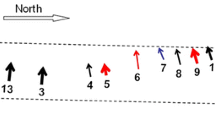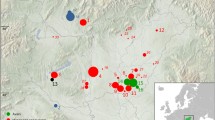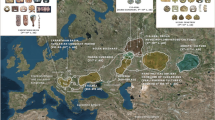Abstract
Historical records suggest that Chiriguano tribe is the result of a genetic admixture event. The process involved the arrival of Guaraní tribesmen descending from Amazonian region of Brazil along with groups of Arawak origin that inhabited the foothill plains of Bolivia. Later they arrived in Argentina at the beginning of the twentieth century. Aiming to test the historical records, we analysed a set of 46 samples collected at San Ramon de la Nueva Orán, Province of Salta, Argentina. A wide set of uni- and biparentally transmitted genetic markers were analysed, including 23 autosomal STRs; 46 AIM-DIPs and 24 AIM-SNPs all located at diverse autosomal chromosome locations; 23 Y-STRs and the entire mtDNA D-Loop sequence. Ancestry informative markers allowed for the detection of a strong Native American component in the genomes (> 94%), while all mtDNA haplotypes showed Native American characteristic motives, and 93% of Y-haplotypes belonged to the Q1a3a Y-haplogroup. The analysis of mitochondrial haplotypes and Y chromosome, although they did not match other populations, revealed a relationship between the Chiriguano and other groups of Guaraní and Arawak origin inhabiting Brazil and Bolivia, confirming, at least in part, the historical records describing the origins of Chiriguano tribal settlements in northwestern Argentina.







Similar content being viewed by others
References
Pifarré F (1989) Los Guaraní-Chiriguanos 2. Historia de un pueblo. Ed. CIPCA, La Paz
Martinez Sarasola C (2005) Nuestros paisanos los indios. Emece Edts, Buenos Aires
Combès I (2005) Etno-historias del Isoso: chané y chiriguanos en el Chaco boliviano. Siglos XVI al XX. Fundación PIEB/IFEA Eds, La Paz
Renard-Casevitz F-M, Saignes T (1988) Al Este de los Andes: relaciones entre las sociedades amazónicas y andinas entre los siglos XV y XVII (I). IFEA, La Paz. http://www.ifea.org.pe
Diaz de Guzman R (2001) Historia Argentina del descubrimiento, población y conquista de las provincias del Río de la Plata/escrita por Ruy Díaz de Guzmán, en el año de 1612. Biblioteca Virtual Miguel de Cervantes, Alicante. http://www.cervantesvirtual.com
Oliveto G (2010) Chiriguanos: la construcción de un estereotipo en la política colonizadora del sur andino. Mem Am 18(1):43–69
Cornbès I (2007) Thierry Saignes, Historia del pueblo Chiriguano. Compilación, introducción y notas. Instituto Francés de Estudios Andinos, Plural editores, La Paz
ECPI (2004–2005) ECPI, Encuesta Complentaria de Pueblos Indigenas. Instituto de Estadísticas y Censos, Buenos Aires. https://www.indec.gob.ar/
World Medical Association (2013) World Medical Association Declaration of Helsinki: ethical principles for medical research involving human subjects. JAMA 310(20):2191–2194
Sambrook J, Fritsch EF, Maniatis T (1989) Molecular cloning: a laboratory manual, 2nd edn. Cold spring harbor laboratory, New York
Ginart S, Caputo M, Alechine E, Corach D, Sala A (2016) Development of a quantitation approach for total human and male DNA based on real time PCR followed by high resolution melting analysis. Electrophoresis 37(21):2734–2741
Corach D, Lao O, Bobillo MC, van Der Gaag K, Zuniga S, Vermeulen M, van Duijn K, Goedbloed M, Vallone PM, Parson W, deKnijff P, Kayser M (2010) Inferring continental ancestry of Argentineans from autosomal, Y-chromosomal and mitochondrial DNA. Ann Hum Genet 74:65–76
Pereira R, Phillips C, Pinto N, Santos C, dos Santos SEB, Amorim A, Carracedo A, Gusmao L (2012) Straightforward inference of ancestry and admixture proportions through ancestry-informative insertion deletion multiplexing. PLoS ONE 7(1):e29684
Brandstätter A, Niederstatter H, Parson W (2004) Monitoring the inheritance of heteroplasmy by computer-assisted detection of mixed basecalls in the entire human mitochondrial DNA control region. Int J Legal Med 118:47–54
Zuccarelli G, Alechine E, Caputo M, Bobillo MC, Corach D, Sala A (2011) Rapid screening for Native American mitochondrial and Y-chromosome haplogroups detection in routine DNA analysis. Forensic Sci Int Genet 5:105–108
Excoffier L, Laval G, Schneider S (2005) Arlequin ver. 3.0: an integrated software package for population genetics data analysis. Evol Bioinform Online 1:47–50
Kumar S, Stecher G, Tamura K (2016) MEGA7: molecular evolutionary genetics analysis version 7.0 for bigger datasets. Mol Biol Evol 33:1870–1874
Kayser M, Caglia A, Corach D, Fretwell N, Gehrig C, Graziosi G, Heidorn F, Herrmann S, Herzog B, Hidding M, Honda K, Jobling M, Krawczak M, Leim K, Meuser S, Meyer E, Oesterreich W, Pandya A, Parson W, Penacino G, Perez-Lezaun A, Piccinini A, Prinz M, Schmitt C, Roewer L et al (1997) Evaluation of Y-chromosomal STRs: a multicenter study. Int J Legal Med 110:125–133
Pritchard JK, Stephens M, Donnelly P (2000) Inference of population structure using multilocus genotype data. Genetics 155:945–959
Lao O, van Duijn K, Kersbergen P, de Knijff P, Kayser M (2006) Proportioning whole-genome single-nucleotidepolymorphism diversity for the identification of geographic population structure and genetic ancestry. Am J Hum Genet 78:680–690
Santos C, Phillips C, Oldoni F, Amigo J, Fondevila M, Pereira R, Carracedo Á, Lareu MV (2015) Completion of a worldwide reference panel of samples for an ancestry informative Indel assay panel. Forensic Sci Int Genet 17:75–80
Earl DA, von Holdt BM (2012) STRUCTURE HARVESTER: a website and program for visualizing STRUCTURE output and implementing the Evanno method. Conserv Genet Resour 4:359–361
Jakobsson M, Rosenberg NA (2007) CLUMPP: a cluster matching and permutation program for dealing with label switching and multimodality in analysis of population structure. Bioinformatics 23:1801–1806
Rosenberg N (2004) Distruct: a program for the graphical display of population structure. Mol Ecol Notes 4:137–138
Bertorelle G, Excoffier L (1998) Inferring admixture proportions from molecular data. Mol Biol Evol 15:1298–1311
Dupanloup I, Bertorelle G (2001) Inferring admixture proportions from molecular data: extension to any number of parental populations. Mol Biol Evol 18:672–675
Roewer L, Nothnagel M, Gusmão L, Gomes V, González M, Corach D, Sala A, Alechine E, Palha T, Santos N, Ribeiro-Dos-Santos A, Geppert M, Willuweit S, Nagy M, Zweynert S, Baeta M, Núñez C, Martínez-Jarreta B, González-Andrade F, Fagundes de Carvalho E, da Silva DA, Builes JJ, Turbón D, Lopez Parra AM, Arroyo-Pardo E, Toscanini U, Borjas L, Barletta C, Ewart E, Santos S, Krawczak M (2013) Continent-wide decoupling of Y-chromosomal genetic variation from language and geography in native South Americans. PLoS Genet 9(4):e1003460
Tirado M, López-Parra AM, Baeza C, Bert F, Corella A, Pérez-Pérez A, Turbón D, Arroyo-Pardo E (2009) Y-chromosome haplotypes defined by 17 STRs included in AmpFlSTR Yfiler PCR Amplification Kit in a multi ethnical population from El Beni Department (North Bolivia). Leg Med 11:101–103
Zhivotovsky LA, Underhill PA, Cinnioğlu C, Kayser M, Morar B, Kivisild T, Scozzari R, Cruciani F, Destro-Bisol G, Spedini G, Chambers GK, Herrera RJ, Yong KK, Gresham D, Tournev I, Feldman MW, Kalaydjieva L (2004) The effective mutation rate at Y chromosome short tandem repeats, with application to human population-divergence time. Am J Hum Genet 74:50–61
Sala A, Argüelles CF, Marino ME, Bobillo C, Fenocchio A, Corach D (2010) Genetic analysis of six communities of Mbyá-Guaraní inhabiting North Eastern Argentina by means of nuclear and mitochondrial polymorphic markers. Hum Biol 82:433–456
Sala A, Corach D (2014) Analysis of admixture and genetic structure of two Native American groups of Southern Argentinean Patagonia. Mol Biol Rep 41:1533–1543
Tarragó MN (2000) Nueva Historia Argentina. Los pueblos originarios y la conquista. Edts Sudamericana, Buenos Aires
Bonferroni CE (1936) Teoria statistica delle classi e calcolo delle probabilita. Pubblicazioni del R Istituto Superiore di Scienze Economiche e. Commerciali di Firenze 8:3–62
Irwin JA, Saunier JL, Niederstätter H, Strouss KM, Sturk KA, Diegoli TM, Brandstätter A, Parson W, Parsons TJ (2009) Investigation of heteroplasmy in the human mitochondrial DNA control region: a synthesis of observations from more than 5000 global population samples. J Mol Evol 68(5):516–527
Li M, Schönberg A, Schaefer M, Schroeder R, Nasidze I, Stoneking M (2010) Detecting heteroplasmy from high-throughput sequencing of complete human mitochondrial DNA genomes. Am J Hum Genet 87(2):237–249
Ballantyne KN, Goedbloed M, Fang R, Schaap O, Lao O, Wollstein A, Choi Y, van Duijn K, Vermeulen M, Brauer S, Decorte R, Poetsch M, von Wurmb-Schwark N, de Knijff P, Labuda D, Vézina H, Knoblauch H, Lessig R, Roewer L, Ploski R, Dobosz T, Henke L, Henke J, Furtado MR, Kayser M (2010) Mutability of Y-chromosomal microsatellites: rates, characteristics, molecular bases, and forensic implications. Am J Hum Genet 10(3):341–353 87(
Kling D, Tillmar AO, Egeland T (2014) Familias 3—extensions and new functionality. Forensic Sci Int Genet 13:121–127
Greenberg JH (1987) Language in the Americas. Stanford University Press, Stanford
Cardenas JM, Heinz T, Pardo-Seco J, Alvarez-Iglesias V, Taboada-Echalar P, Sanchez-Diz P, Carracedo A, Salas A (2015) The multiethnic ancestry of Bolivians as revealed by the analysis of Y-chromosome markers. Forensic Sci Int Genet 14:210–218
Guevara EK, Palo JU, Guillén S, Sajantila A (2016) MtDNA and Y-chromosomal diversity in the Chachapoya, a population from the northeast Peruvian Andes-Amazon divide. Am J Hum Biol 28(6):857–867
Sandoval JR, Lacerda DR, Jota MS, Salazar-Granara A, Vieira PP, Acosta O, Cuellar C, Revollo S, Fujita R, Santos FR, Genographic Project Consortium (2013) The genetic history of indigenous populations of the Peruvian and Bolivian Altiplano: the legacy of the Uro. PLoS ONE 8(9):e73006. https://doi.org/10.1371/journal.pone.0073006
Barbieri C, Heggarty P, Yang Yao D, Ferri G, De Fanti S, Sarno S, Ciani G, Boattini A, Luiselli D, Pettener D (2014) Between Andes and Amazon: the genetic profile of the Arawak-speaking Yanesha. Am J Phys Anthropol 155(4):600–609. https://doi.org/10.1002/ajpa.22616
Fischermann B (2010) Pueblos Indígenas y Nacionales Originarios en Bolivia Tierras Bajas: Pueblo Mojeño. En: Atlas Territorios Indígenas y Originarios en Bolivia, MDRyT-Viceministerio de Tierra, La Paz, pp 55–56
INE (2012) Instituto Nacional de Estadística, Gobierno de Bolivia. Censo Nacional de Población y Vivienda 2012. https://www.ine.gob.bo
DGEEC (2012) Dirección General de Estadística, Encuestas y Censo, Gobierno de Paraguay. III Censo Nacional de Población y Viviendas para Pueblos Indígenas 2012. http://www.dgeec.gov.py
Taboada-Echalar P, Alvarez-Iglesias V, Heinz T, Vidal-Bralo L, Gomez-Carballa A, Catelli L, Pardo-Seco J, Pastoriza A, Carracedo A, Torres-Balanza A, Rocabado O, Vullo C, Salas A (2013) The genetic legacy of the pre-colonial period in contemporary bolivians. PLoS ONE 8(3):E58980
Sandoval JR, Lacerda DR, Acosta O, Jota MS, Robles-Ruiz P, Salazar-Granara A, Vieira PP, Paz-Y-Miño C, Fujita R, Santos FR, Genographic Project Consortium (2016) The genetic history of Peruvian Quechua-Lamistas and Chankas: uniparental DNA patterns among Autochthonous Amazonian and Andean populations. Ann Hum Genet 80(2):88–101
Alves-Silva J, da Silva Santos M, Guimaraes P, Ferreira A, Bandelt H-J, Pena S, Ferreira Prado V (2000) The ancestry of Brazilian mtDNA lineages. Am J Hum Genet 67:444–461
Sala A, Alechine E, Bobillo C, Merini L, Ayala C, Acosta Ferreira JC, Corach D (2009) Mitochondrial DNA control region sequence analysis of Mataco–Guaicuru speaking tribes from Argentina. Forensic Sci Int 2:331–333
Behar DM, van Oven M, Rosset S, Metspalu M, Loogvali EL, Silva NM, Kivisild T, Torroni A, Villems RA (2012) ‘Copernican’ reassessment of the human mitochondrial DNA tree from its root. Am J Hum Genet 90(4):675–684
Achilli A, Perego UA, Bravi CM, Coble MD, Kong QP, Woodward SR, Salas A, Torroni A, Bandelt HJ (2008) The phylogeny of the four pan-American MtDNA haplogroups: implications for evolutionary and disease studies. PLoS ONE 3(3):e1764
Kumar S, Bellis C, Zlojutro M, Melton PE, Blangero J, Curran JE (2011) Large scale mitochondrial sequencing in Mexican Americans suggests a reappraisal of Native American origins. BMC Evol Biol 7:11:293
Hartmann A, Thieme M, Nanduri LK, Stempfl T, Moehle C, Kivisild T, Oefner PJ (2009) Validation of microarray-based resequencing of 93 worldwide mitochondrial genomes. Hum Mutat 30(1):115–122
Perego UA, Achilli A, Angerhofer N, Accetturo M, Pala M, Olivieri A, Hooshiar Kashani B, Ritchie KH, Scozzari R, Kong QP, Myres NM, Salas A, Semino O, Bandelt HJ, Woodward SR, Torroni A (2009) Distinctive Paleo-Indian migration routes from Beringia marked by two rare mtDNA haplogroups. Curr Biol 19(1):1–8
Tamm E, Kivisild T, Reidla M et al (2007) Beringian standstill and spread of native american founders. PLoS ONE 2(9):e829. https://doi.org/10.1371/journal.pone.0000829
Sukernik RI, Volodko NV, Mazunin IO, Eltsov NP, Dryomov SV, Starikovskaya EB (2012) Mitochondrial genome diversity in the Tubalar, Even, and Ulchi: contribution to prehistory of native Siberians and their affinities to Native Americans. Am J Phys Anthropol 148(1):123–138
Bobillo MC, Zimmermann B, Sala A, Huber G, Röck A, Bandelt H-J, Corach D, Parson W (2010) Amerindian mitochondrial DNA haplogroups predominate in the population of Argentina: towards a first nationwide mitochondrial DNA sequence database. Int J Legal Med 124:263–268
Acknowledgements
This work was partly supported, by Grants UBACyT 20020130100783BA and CONICET PIP11220150100349 CO.
Author information
Authors and Affiliations
Corresponding author
Ethics declarations
Conflict of interest
The authors declare that the are no conflict of interest.
Electronic supplementary material
Below is the link to the electronic supplementary material.
Rights and permissions
About this article
Cite this article
Sala, A., Caputo, M., Ginart, S. et al. Historical records under the genetic evidence: “Chiriguano” tribe genesis as a test case. Mol Biol Rep 45, 987–1000 (2018). https://doi.org/10.1007/s11033-018-4246-0
Received:
Accepted:
Published:
Issue Date:
DOI: https://doi.org/10.1007/s11033-018-4246-0




